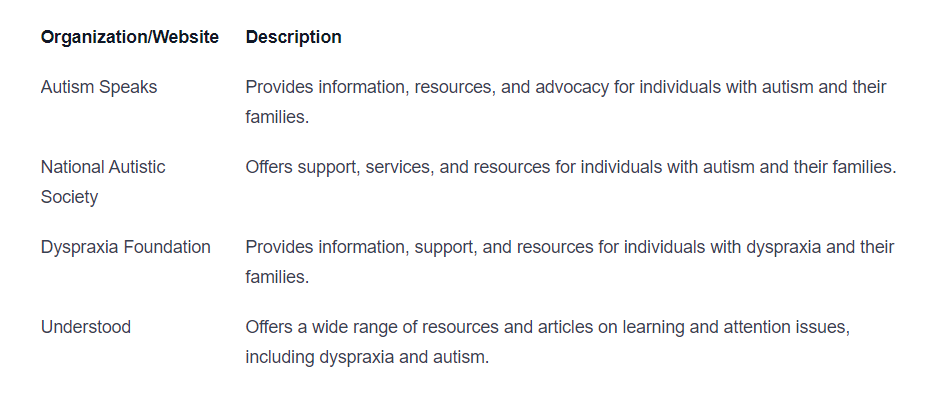Dyspraxia and Autism | Definition and Differences
Unveiling the differences between dyspraxia and autism. Explore their definitions, traits, and support strategies. Learn more!

Understanding Dyspraxia and Autism
To gain a deeper understanding of dyspraxia and autism, it is essential to first grasp the individual concepts of each condition.

What is Dyspraxia?
Dyspraxia, also known as Developmental Coordination Disorder (DCD), is a neurodevelopmental disorder that affects movement and coordination. Individuals with dyspraxia often struggle with planning and executing fine and gross motor skills, such as tying shoelaces, riding a bike, or even maintaining balance. This difficulty in coordinating movements can impact various aspects of their daily lives, including self-care, academics, and leisure activities.
What is Autism?
Autism, or Autism Spectrum Disorder (ASD), is a complex neurodevelopmental condition that affects social interaction, communication, and behavior. People with autism may experience challenges in interpreting and responding to social cues, engaging in reciprocal conversations, and understanding nonverbal communication. Additionally, individuals with autism may display repetitive behaviors, restricted interests, and sensory sensitivities. Autism is a spectrum disorder, meaning that it can manifest in a wide range of ways and varying degrees of severity.
Understanding the individual definitions of dyspraxia and autism provides a foundation for exploring the characteristics, differences, and similarities between these two conditions. Let's further delve into the distinct features and challenges associated with dyspraxia and autism.
Definition and Overview
To gain a deeper understanding of dyspraxia and autism, it is essential to explore their definitions and characteristics separately. Let's delve into the definitions and key characteristics of dyspraxia and autism.
Dyspraxia: Definition and Characteristics
Dyspraxia, also known as Developmental Coordination Disorder (DCD), is a neurodevelopmental disorder that affects motor coordination and planning. Individuals with dyspraxia may experience difficulties with fine and gross motor skills, coordination, and spatial awareness. These challenges can impact various aspects of their daily lives, such as self-care, handwriting, and participating in sports or physical activities.
Here are some key characteristics associated with dyspraxia:
Characteristics
Difficulty with coordination and motor skills
Poor balance and posture control
Challenges with handwriting and fine motor tasks
Trouble with organizing and planning movements
Difficulty with spatial awareness and sense of direction
It's important to note that dyspraxia is not related to intelligence, and individuals with this condition can excel in areas unrelated to motor skills.
Autism: Definition and Characteristics
Autism, also known as Autism Spectrum Disorder (ASD), is a complex neurodevelopmental disorder characterized by challenges in social interaction, communication, and restricted or repetitive behaviors. Autism affects individuals differently, resulting in a wide range of abilities and challenges.
Here are some key characteristics associated with autism:
Characteristics
Difficulty with coordination and motor skills
Poor balance and posture control
Challenges with handwriting and fine motor tasks
Trouble with organizing and planning movements
Difficulty with spatial awareness and sense of direction
Autism is a spectrum disorder, meaning that individuals can experience a wide range of symptoms and severity levels. It's important to recognize that each person with autism is unique, and their strengths and challenges can vary significantly.
Understanding the definitions and characteristics of dyspraxia and autism provides a foundation for recognizing their differences and similarities. In the following sections, we will explore the key differences and overlapping traits between these two conditions, as well as the importance of diagnosis and support.
Key Differences
When comparing dyspraxia and autism, there are several key differences that set them apart. These differences can be observed in the areas of motor skills and coordination, social interaction and communication, and sensory processing.
Motor Skills and Coordination
One of the primary differences between dyspraxia and autism lies in the domain of motor skills and coordination. Dyspraxia, also known as developmental coordination disorder (DCD), is characterized by difficulties in planning and executing coordinated movements. Individuals with dyspraxia may struggle with activities such as tying shoelaces, handwriting, and playing sports. Their movements may appear clumsy or uncoordinated.
On the other hand, while motor difficulties can be present in individuals with autism, they are not a defining feature of the condition. Autism primarily affects social interaction and communication, with motor challenges being secondary. Some individuals with autism may exhibit motor delays or atypical movements, but these are not exclusive to autism and can vary greatly between individuals.
Social Interaction and Communication
Social interaction and communication are key areas where dyspraxia and autism differ. Individuals with dyspraxia typically do not experience significant difficulties in social interaction or communication. Their challenges are primarily related to motor skills and coordination.
Autism, on the other hand, is characterized by persistent difficulties in social interaction and communication. Individuals with autism may struggle with understanding social cues, maintaining eye contact, engaging in reciprocal conversations, and interpreting nonverbal communication. These difficulties can range from mild to severe and impact various aspects of daily life.
Sensory Processing
Sensory processing differences are another area where dyspraxia and autism diverge. Dyspraxia primarily affects motor planning and execution, while sensory processing difficulties are common in individuals with autism. Sensory processing issues in autism can manifest as hypersensitivity (over-responsiveness) or hyposensitivity (under-responsiveness) to sensory stimuli such as touch, sound, taste, smell, and visual input.
In contrast, individuals with dyspraxia may have sensory issues related to motor coordination. For example, they may struggle with proprioception, which is the sense of body awareness and positioning. These sensory difficulties in dyspraxia are more closely linked to motor challenges rather than broader sensory processing issues seen in autism.
Understanding these key differences between dyspraxia and autism is crucial in order to provide appropriate support and interventions for individuals with these conditions. While there may be overlapping traits and challenges, recognizing their unique characteristics is essential for tailored approaches to diagnosis, intervention, and support.
Overlapping Traits and Challenges
While dyspraxia and autism are distinct conditions, they share certain traits and challenges. Understanding these overlapping areas can provide valuable insights into the experiences of individuals with dyspraxia and autism.
Similarities in Sensory Issues
Both dyspraxia and autism can involve sensory processing difficulties. Individuals with dyspraxia may have challenges with sensory integration, which can affect their ability to process and respond to sensory information from the environment. Similarly, individuals with autism may experience sensory sensitivities or sensory overload, where certain sounds, textures, or lights can be overwhelming or distressing.

Overlapping Executive Function Difficulties
Executive function refers to a set of cognitive processes responsible for planning, organizing, and carrying out tasks. Both dyspraxia and autism can present challenges in this area. Individuals with dyspraxia may struggle with organizing their thoughts, time management, and problem-solving. Similarly, individuals with autism may experience difficulties with planning, initiating tasks, and maintaining attention.

Co-occurrence of Dyspraxia and Autism
It is not uncommon for dyspraxia and autism to co-occur. Research suggests that there is an increased likelihood of individuals with autism also having dyspraxia. This overlap can lead to a more complex set of challenges and may require a comprehensive approach to intervention and support.

Understanding the similarities in sensory issues and executive function difficulties can help professionals and caregivers develop appropriate interventions and support strategies for individuals with dyspraxia and autism. It is important to recognize the unique strengths and challenges of each individual and tailor interventions to their specific needs. By providing a supportive and inclusive environment, individuals with dyspraxia and autism can thrive and reach their full potential.
Diagnosis and Support
When it comes to dyspraxia and autism, early diagnosis and appropriate support are crucial for individuals to thrive. In this section, we will explore the process of diagnosing dyspraxia and autism, as well as intervention and support strategies that can make a positive difference. We will also provide some resources for individuals and families seeking further information and assistance.
Diagnosing Dyspraxia and Autism
Diagnosing dyspraxia and autism involves a comprehensive assessment conducted by healthcare professionals, typically including occupational therapists, psychologists, and developmental pediatricians. These assessments may involve a combination of interviews, observations, and standardized tests to gather information about an individual's motor skills, communication abilities, social interaction, and sensory processing.
Diagnosing Dyspraxia
The diagnosis of dyspraxia, also known as developmental coordination disorder (DCD), focuses on evaluating an individual's motor skills and coordination difficulties. The assessment may include tests that assess fine motor skills, gross motor skills, and coordination abilities. It is important to note that dyspraxia can coexist with other conditions, such as autism, ADHD, or learning disabilities.
Diagnosing Autism
Autism is typically diagnosed through a comprehensive evaluation of an individual's social interaction, communication skills, and behavior patterns. Healthcare professionals may use standardized tools, such as the Autism Diagnostic Observation Schedule (ADOS) and the Autism Diagnostic Interview - Revised (ADI-R), along with clinical judgment, to determine if an individual meets the criteria for an autism spectrum disorder (ASD) diagnosis.
Intervention and Support Strategies
Once a diagnosis of dyspraxia or autism is made, appropriate intervention and support strategies can significantly enhance an individual's quality of life. The specific strategies may vary based on the individual's unique needs and challenges. It is important to involve a multidisciplinary team, including occupational therapists, speech-language pathologists, psychologists, educators, and parents, to develop an individualized plan.
Dyspraxia Intervention and Support
Interventions for dyspraxia primarily focus on improving motor skills, coordination, and functional abilities. Occupational therapy plays a crucial role in providing strategies to enhance fine motor skills, gross motor skills, and coordination. The therapist may recommend activities and exercises to improve balance, coordination, and body awareness. Additionally, accommodations and adaptations in educational settings can help individuals with dyspraxia succeed academically.
Autism Intervention and Support
For individuals with autism, early intervention is key to improving social communication skills, behavior regulation, and overall functioning. Applied Behavior Analysis (ABA) therapy is widely used to target specific skills and reduce challenging behaviors. Speech therapy can help individuals develop communication skills, while occupational therapy focuses on enhancing sensory processing and daily living skills. Special education programs tailored to the individual's needs also play a crucial role in supporting academic and social development.
Resources for Individuals and Families
Finding reliable resources and support can be invaluable for individuals and families affected by dyspraxia or autism. Here are some organizations and websites that offer information, guidance, and community support:

Remember, a diagnosis of dyspraxia or autism does not define an individual's potential. With the right support, understanding, and accommodations, individuals can thrive and lead fulfilling lives.
Sources
https://study.com/academy/lesson/dyspraxia-autism-overlaps-differences.html
https://www.abtaba.com/blog/dyspraxia-and-autism
https://theblogwithonepost.wordpress.com/2015/08/19/dyspraxia-autism-the-overlap/
Similar articles
We’re here to help you

Our team is here to assist you in this process. Contact us for any assistance.
it’s easy to apply
We Accept Most Insurances
Our in-network insurance partnerships make ABA therapy more accessible to families throughout our service areas.







Our Insurance Process
We'll request your insurance details to help us verify your plan's coverage for ABA therapy. Once we've received this information, we'll walk you through your benefits, including copayments, deductibles and out-of-pocket maximums, so you know what to expect in advance.
Our team will then handle the preauthorization and all the necessary paperwork.
.svg)





















.jpeg)


































.jpeg)




.jpeg)







.jpeg)











.jpeg)
















